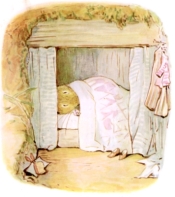-
History of:
- Resources about:
- More:
- Baby walkers
- Bakehouses
- Bed warmers
- Beer, ale mullers
- Besoms, broom-making
- Box, cabinet, and press beds
- Butter crocks, coolers
- Candle snuffers, tallow
- Clothes horses, airers
- Cooking on a peat fire
- Drying grounds
- Enamel cookware
- Fireplaces
- Irons for frills & ruffles
- Knitting sheaths, belts
- Laundry starch
- Log cabin beds
- Lye and chamber-lye
- Mangles
- Marseilles quilts
- Medieval beds
- Rag rugs
- Rushlights, dips & nips
- Straw mattresses
- Sugar cutters - nips & tongs
- Tablecloths
- Tinderboxes
- Washing bats and beetles
- Washing dollies
- List of all articles
Subscribe to RSS feed or get email updates.
Box-beds and Bed-recesses:
The use of closed-in beds was formerly widespread both in the towns and the country districts of Scotland. The old type of completely enclosed beds, usually with folding doors like a cupboard, has, in the main, disappeared from the towns, though its existence is noted in the evidence from certain northern districts, particularly Orkney and Shetland; but the bed-recess, which is frequently enclosed for part of its length, is still common.
1918, Report of Royal Commission on the Housing of the Industrial Population of Scotland
...there was Mrs. Tittlemouse's bedroom, where she slept in a little box bed!
Beatrix Potter, The Tale of Mrs. Tittlemouse, 1910
Press beds
Box beds, bed recesses, press, wainscot, wardrobe and cabinet beds
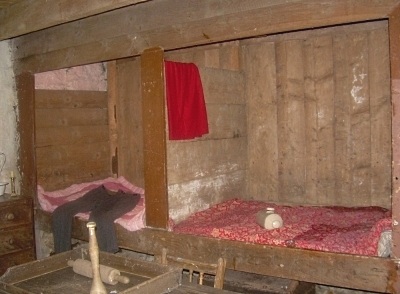 This pair of beds takes up the whole
of one side of the main living-room/kitchen in a Scottish Highlands cottage. And,
yes, the second one is even shorter than the first - presumably for children, since
even the main bed is small by modern standards. Scotland has a strong tradition
of box beds, which are more part of the architecture than pieces of furniture. (See
cottage floor plan lower down page.)
This pair of beds takes up the whole
of one side of the main living-room/kitchen in a Scottish Highlands cottage. And,
yes, the second one is even shorter than the first - presumably for children, since
even the main bed is small by modern standards. Scotland has a strong tradition
of box beds, which are more part of the architecture than pieces of furniture. (See
cottage floor plan lower down page.)
Beds built into recesses and attached to the panelling and roof timbers are warm and semi-private, especially when curtains are drawn across them or they're fully enclosed with door panels, like the famous lits clos in Brittany. Some areas of the UK also had free-standing box beds, like this Welsh wainscot bed. Both kinds were familiar in regions of Northern Europe, but people not used to the tradition might find them strange. When Mr. Lockwood stayed the night at Wuthering Heights he looked round for his bed, and found it inside a "little closet". (See bottom of page) He sounds surprised, and unused to life in northern England.
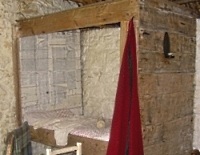 The free-standing box or press bed developed
into a very sophisticated piece of furniture in the 18th century, when cabinet-makers
designed "secret" press beds disguised as wardrobes or sideboards, or hidden behind
rows of bookshelves and drawers. Even when there was no pressure on space, and no
need to provide a mini-bedroom within a shared living area, these were fashionable
items, said to be particularly popular with young gentlemen in London.
The free-standing box or press bed developed
into a very sophisticated piece of furniture in the 18th century, when cabinet-makers
designed "secret" press beds disguised as wardrobes or sideboards, or hidden behind
rows of bookshelves and drawers. Even when there was no pressure on space, and no
need to provide a mini-bedroom within a shared living area, these were fashionable
items, said to be particularly popular with young gentlemen in London.
In the 19th century press beds - (press means cupboard or closet) - took on a new form, as various kinds of folding bed were developed and tidied away into wardrobes and cabinets. This unusual American folding bed is designed for the parlour, and this cabinet bed has become almost famous. If the folding bed was wanted in a bedroom it might be tucked into a wardrobe, like one advertised in late Victorian England as a "servant's press bedstead".
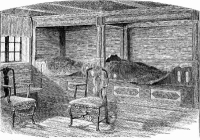 Some early settlers in North America
constructed houses with enclosed or recessed beds. The Dutch tradition was evident
in New York, where building a house for the Brooklyn ferry-master in 1655 involved
an agreement to "wainscot the east side the whole length of the house, and in the
recess two bedsteads, one in the front room and one in the inside room, with a pantry
at the end of the bedstead". Samuel Pepys met this tradition in the
Hague and wrote in his diary, "After supper the Judge and I to another house, [...]
and he and I lay in one press bed, there being two more in the same room, but all
very neat and handsome, my boy sleeping upon a bench by me."
Some early settlers in North America
constructed houses with enclosed or recessed beds. The Dutch tradition was evident
in New York, where building a house for the Brooklyn ferry-master in 1655 involved
an agreement to "wainscot the east side the whole length of the house, and in the
recess two bedsteads, one in the front room and one in the inside room, with a pantry
at the end of the bedstead". Samuel Pepys met this tradition in the
Hague and wrote in his diary, "After supper the Judge and I to another house, [...]
and he and I lay in one press bed, there being two more in the same room, but all
very neat and handsome, my boy sleeping upon a bench by me."
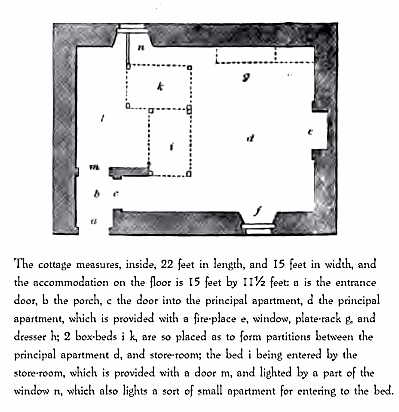
Not all these beds were as plain as the 19th century pine box (higher up). The engraving (above) of a pair of nicely-carved Scandinavian beds shows how they could be quite elegant. This Scottish bed is simpler, but with mouldings that set it well above the plainest kind. In 1893 Litchfield's History of Furniture commented on "the old-fashioned box-like bedsteads which the Norwegians had retained from early times, and which in a ruder form are still to be found in the cottages of many Scottish counties, especially of those where the Scandinavian connection existed". This included Shetland box beds.
As the 19th century brought a concern for hygiene alongside a belief in fresh air, there were doubts about luxuriating in featherbeds and sleeping in curtained four-posters, and the fully-enclosed press or box bed was criticised as unhealthy. Not only did the limited access make it unsuitable for invalids, and difficult to clean, but the air inside was stale; it was seen as a breeding-ground for bed-bugs, germs and dirt. All the same, it was considered a fact of life in some places. In Scotland, for example, cottages and urban tenement houses were being designed with box beds or bed recesses until at least 1900. The 1841 plan for a farm labourer's cottage (right) came with this comment:
It is not probable, however, that box-beds, which are really warm and comfortable within, will ever be laid aside, though of inconvenient construction for sick people. Modifications of their form have been recommended by medical men, consisting chiefly in having the back and ends to open on hinges, and the top made movable, for the sake of promoting ventilation, as well as of affording easy access to patients. Curtains suspended from movable rods, which may be drawn forward, have also been recommended to be placed in front, instead of sliding panels, to screen the people while dressing and undressing, in cases where the beds do not occupy separate apartments.
Henry Stephens, The Book of the Farm, 1841
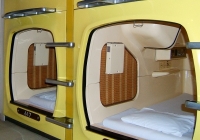 Let's end with this picture from a Japanese
capsule hotel. Like traditional wooden press and box beds, the capsules sit on a
blurred dividing line between bed and bedroom: a private space for those within
the capsule, a place to sleep, but is it truly a room?
Let's end with this picture from a Japanese
capsule hotel. Like traditional wooden press and box beds, the capsules sit on a
blurred dividing line between bed and bedroom: a private space for those within
the capsule, a place to sleep, but is it truly a room?
... I fastened my door and glanced round for the bed. The whole furniture consisted of a chair, a clothes-press, and a large oak case, with squares cut out near the top resembling coach windows. Having approached this structure, I looked inside, and perceived it to be a singular sort of old-fashioned couch, very conveniently designed to obviate the necessity for every member of the family having a room to himself. In fact, it formed a little closet, and the ledge of a window, which it enclosed, served as a table. I slid back the panelled sides, got in with my light, pulled them together again, and felt secure against the vigilance of Heathcliff, and every one else.
Emily Bronte, Wuthering Heights, 1847
Footnote: there seem to be no hard-and-fast definitions of press beds, box beds, and all the other names. The dictionary (OED) says a box bed has "two sliding panels or shutters", but the name is often used for beds open or half-open on one side. A press bed may be free-standing or built in when a house is constructed. And so on ...
You may also like:
- Box beds in Brittany
- Straw mattresses
- Bed warmers
- Featherbeds
- One-legged beds
- Medieval beds - with glossary
- Marseilles quilts
 18 July 2007
18 July 2007
You may like our new sister site Home Things Past where you'll find articles about antiques, vintage kitchen stuff, crafts, and other things to do with home life in the past. There's space for comments and discussion too. Please do take a look and add your thoughts. (Comments don't appear instantly.)
For sources please refer to the books page, and/or the excerpts quoted on the pages of this website, and note that many links lead to museum sites. Feel free to ask if you're looking for a specific reference - feedback is always welcome anyway. Unfortunately, it's not possible to help you with queries about prices or valuation.


